Work on the script continues, and before long we will edit the video and begin distribution. Even as we work to complete the documentary, work on the construction of the nursing home in Cali, Colombia, South America continues. When there is money for supplies, the workers build. When the money runs out, construction slows. Therefore, our fundraising attention for 2007 has turned away from the documentary and toward direct funding of the construction itself.
Whether you are wrapping up your charitable giving for 2006 or looking ahead to 2007, I hope you'll consider the Hogar Samaria nursing home project in your plans. The fundraisers have absolutely no overhead costs. That means every penny or peso you donate goes directly into Hogar Samaria. And a little money can go a long way in Colombia. For example:
$3.25 will feed one Hogar Samaria nursing home resident for one day.
$25.00 will provide much-needed medical insurance for one Hogar Samaria resident for one month.
$260.00 will sponsor one Hogar Samaria resident for one month (including meals).
$2000.00 will provide basic furnishings for one room that will accommodate two residents.
$25,000.00 will provide for the building of a chapel at Hogar Samaria.
$5000.00 will provide basic furnishings for the chapel.
Currently, the most urgent need is funding for the construction of a retaining wall at the back of the Hogar Samaria property. The 20-feet high, 100-feet long wall will protect the property from washing away. The cost of the retaining wall is $25,000.00.
If you feel compelled to give financial support to the construction of this much-needed nursing home in Cali, Colombia, your donations are tax-deductible. Contact me at p.richelle@earthlink.net to find out how to direct your donations. The leaders of the project will put your money to work immediately where it is most needed.
Whether you decide to donate to Hogar Samaria or not, I hope you will share my URL with others who may be interested in the work we're doing in Cali.
Wednesday, December 27, 2006
Monday, August 21, 2006
Construction Update
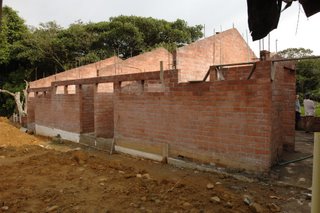 Workers are busy putting the roof on the second building at Hogar Samaria. Next, they will build a retaining wall at the far end of the site, where the January work team from the U.S. will begin construction of the third building. Funds are needed for the retaining wall project, so we're putting out an urgent call for donations... large and small.
Workers are busy putting the roof on the second building at Hogar Samaria. Next, they will build a retaining wall at the far end of the site, where the January work team from the U.S. will begin construction of the third building. Funds are needed for the retaining wall project, so we're putting out an urgent call for donations... large and small.By the way, the existing "old house" on the property has been rehabbed and is now ready to accept a few residents. As I learn more about that, I'll post updates.
(photo by Mark Mosrie, March 2006)
Sunday, August 13, 2006
Cali Fire Update
I have a little bit more information about the fire at the Ramate de Sande Invasion on the Cauca River, about 10 miles east of Cali in the neighborhood we know as San Marcos.
The fire destroyed 100-150 homes, or more accurately, "shacks." Among the shacks lost in the fire was the home of the two main leaders of a mission and small school that was recently started in this poor area by the San Marcos Church. The home where the mission and school meet was *not* burned down.
Many of you have sent money to help with relief efforts. The need is great, and if you would like to help you may send a check made out to Board of Missions. Be sure to indicate "for Cali Fire" on the memo line. Send to Board of Missions, 1978 Union Avenue, Memphis, TN 38104. Let them know you've been following this story on our web site.
Thanks for your continued support for the people of Cali.
The fire destroyed 100-150 homes, or more accurately, "shacks." Among the shacks lost in the fire was the home of the two main leaders of a mission and small school that was recently started in this poor area by the San Marcos Church. The home where the mission and school meet was *not* burned down.
Many of you have sent money to help with relief efforts. The need is great, and if you would like to help you may send a check made out to Board of Missions. Be sure to indicate "for Cali Fire" on the memo line. Send to Board of Missions, 1978 Union Avenue, Memphis, TN 38104. Let them know you've been following this story on our web site.
Thanks for your continued support for the people of Cali.
Tuesday, August 08, 2006
¡Muchos gracias, Aldemar y Zobeida!
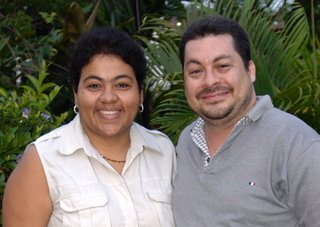 Aldemar's footage is here and is absolutely everything I'd hoped for.
Aldemar's footage is here and is absolutely everything I'd hoped for. Try to imagine what it must be like to take direction through a series of e-mails sent to your wife from a client in another country... a client who manages to butcher your language in her determined effort to convey to you exactly what she needs you to shoot and exactly how she needs you to shoot it.
But thanks to their patience -- and the helpful intervention of missionary Boyce Wallace -- Aldemar and Zobeida were able to pull it off beautifully. (¡Lo hicimos!) And the documentary will be so much more emotive and evocative as a result of their fine work.
(photo by Mark Mosrie)
Wednesday, August 02, 2006
A Plea for Aid in Cali, Colombia
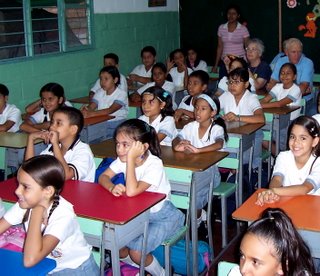 On both of my visits to Cali, I was fortunate enough to get to spend some time in the Colegio Americano in San Marcos. San Marcos is an impoverished barrio in Cali. A teacher at the school told me that unemployment in this particular neighborhood is at about 80%. "It's not that the people don't want to work," she explained. "It's just that there are no jobs."
On both of my visits to Cali, I was fortunate enough to get to spend some time in the Colegio Americano in San Marcos. San Marcos is an impoverished barrio in Cali. A teacher at the school told me that unemployment in this particular neighborhood is at about 80%. "It's not that the people don't want to work," she explained. "It's just that there are no jobs."San Marcos is an invasion zone. That is, it's an area of land on the outskirts of a city where displaced families have rushed in and built crude shacks. Typically, Colombia's displaced are people who have fled from their homes in the mountains to Colombia's urban areas in order to escape guerilla violence. Former missionary to Colombia John Lovelace says that the poorest of the poor live in these invasion zones.
The news from Cali this week comes from our friend Boyce Wallace, who -- along with his wife Beth -- has been a missionary to Colombia for 43 years. Boyce writes: "There was a terrible fire in an invasion zone where San Marcos has a mission and a small school. Around 100 houses were burned down. They were wooden shacks and people lost everything. We are trying to get organized to offer relief."
If you would like to help the people of San Marcos, make your check to Boyce Wallace. Earmark the donation "for San Marcos" and send it to John Lovelace, 814 Crestwood Drive, Evansville, IN 47715. John will deposit your donation directly into Boyce's account so that he can begin to put the money to use immediately. Please drop me an e-mail to let me know the amount of your donation so that we can let Boyce know the money is coming.
Thanks for your continued support of our friends in Cali, Colombia.
(About the photo: Students in a San Marcos classroom show off their English language skills during our visit in September 2005. Photo by Sam Suddarth.)
Thursday, July 06, 2006
The Newest Member of our Documentary Team
 The call went out for a freelance videographer in Cali who could help us obtain some additional footage for the documentary. Today I learned that Aldemar Osorio has accepted that call. I could not be more excited!
The call went out for a freelance videographer in Cali who could help us obtain some additional footage for the documentary. Today I learned that Aldemar Osorio has accepted that call. I could not be more excited!Aldemar and his wife Zobeida met with us while we were in Cali and gave us some archive footage, taken in some of Cali's most dangerous barrios. It was the kind of footage we had dreamed of shooting but that we just could not safely do while we were there.
Now Aldemar is going back out on the streets to shoot some specific scenes to help us better tell the story of the crisis that faces Cali's elderly. We are pleased to count him as the newest member of our production team and just wanted to take a moment to introduce him to you.
Aldemar has done a lot of freelance work for US television networks, including the History Channel. He's a real pro and a welcome addition to our team. Gracias, Aldemar.
This photograph is of Aldemar, taken during our visit in March 2006. I wanted to get a shot of him, and as I was straightening him up a little bit, Mark snapped this. I thought it might be nice to share a playful moment from our time in Cali. The people there were so good to us and such gracious and accommodating hosts. That should not be lost among the telling of some of the difficult stories we'll be sharing with you over the coming weeks.
(Photo by Mark Mosrie)
Cali's Elderly
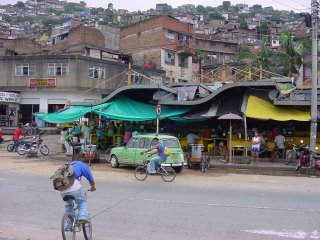 To highlight the magnitude of the crisis facing Cali's elderly, I wanted to share with you some info from Colombia's National Department of Statistics.
To highlight the magnitude of the crisis facing Cali's elderly, I wanted to share with you some info from Colombia's National Department of Statistics.Cali has a population of just over 2.5 million people. Of those, 400,000 are of age 65 or older. Fully one fourth of these elderly live below Colombia's poverty level. That's 100,000 elderly people living below poverty in Cali.
Many of Cali's elderly are among the country's displaced. "Displaced" is the term for a refugee who has fled from one part of the country to another due to violence, political unrest, poverty or other hardship. The number of displaced in Cali who are over age 65 is estimated at 2000. In actuality, that number is likely much higher, as it is difficult to get the displaced to register with the government. They fear being sent back to the place from which they have fled.
100,000 elderly living below poverty.
2,000 elderly displaced.
What can we do to help?
The average cost of caring for an elderly person in Cali is US$3000/year. Upon completion, the Hogar Samaria facililty will be able to tend to the needs of many of Cali's elderly, offering live-in care at the facility for those who need round-the-clock housing and care. It will also offer a daycare program at the facility for those who only need care and attention part-time.
Search your heart and discover what you have to offer Cali's elderly. Perhaps you can give of your time and join the work group from the US to help with construction. Perhaps you can give of your talents and offer help with the documentary project. Perhaps you can give financially to the video project or to the construction project itself.
I welcome every opportunity to discuss the work being done with Cali's elderly. Feel free to contact me with questions about the project and with offers to support the project at any level.
Thanks for your interest and continued support.
(Photo by P.Richelle White)
Tuesday, June 13, 2006
Don Alberto, The Teacher
 We spent one morning in the home of Alberto Moreno. His modest apartment consists of a tiny living room, bathroom, bedroom and kitchen, dimly lit and sparcely furnished. The kitchen appliances are old -- like props for a movie, set in the 1950s.
We spent one morning in the home of Alberto Moreno. His modest apartment consists of a tiny living room, bathroom, bedroom and kitchen, dimly lit and sparcely furnished. The kitchen appliances are old -- like props for a movie, set in the 1950s. As we walk through the apartment, I notice something about Don Alberto that you may have noticed about your parents or grandparents who are near his age. That is, he saves everything. I mean everything. There are neat little stacks of things like breadwrappers, styrofoam meat trays and cardboard cookie boxes. In every little nook, there are tidy stacks of things he just cannot throw out. And though they seem to almost overtake the room, I imagine how empty the space would be without them.
And then I see it... the one thing that almost seems to sum up the life of this beloved teacher: his books. Along the back wall of the kitchen, there are hundreds and hundreds of books. Many appear to be books he taught from during his years at the Colegio Americano. They fill the shelves and even overflow them into cardboard boxes in the living room closet. As I scan the titles, I imagine the young Alberto Moreno who used to read them. And I sense that having them with him here makes this tiny apartment feel like home.
The life that came before his time in this apartment was full and rich. As a young boy, Don Alberto went to elementary in the San Nicolás barrio of Cali. The neighborhood did not have offer secondary education, so after Don Alberto completed elementary school, his mother took him to find a school where he could continue his studies. They went to a union mission in their neighborhood, which was in the process of creating the first Colegio Americano in Cali. The missionaries, Don Carlos Charman and Mr. Walter Louis, admitted Don Alberto, and he become one of the school's first ten or fifteen students. Tuition at that time was one peso. After graduating high school at the Colegio Americano, Don Moreno became a teacher and carried out 21 years of service there.
It's sad to me that a man who spent his young life teaching other people's children and serving his community should live out his last days alone in this apartment. Don Alberto never married. Instead, he cared for his own aging mother until she passed away. But he was already 70 when his mother died, and so much of life had passed him by. He has no family. He has outlived all of his friends, except for one, me mentions -- Don José Fajardo, who now lives in the United States. But he has a very good friend, a former student, who looks after him as best as she and her husband can.
Don Alberto's health is failing, but he would like to live independently as long as he can. When Hogar Samaria is ready, he will have a room there to fill with his precious books. He says he knows he will have a better standard of life there.
I asked him, "If not for the Hogar Samaria, where would you go?"
"Well, frankly," he answers, "I don't know."
(photo by Mark Mosrie)
Wednesday, May 31, 2006
Get Your Hands Dirty

Don't just sit there. Do something. Organizers are planning to take a work group from the U.S. to Cali in early 2007 to help with the construction of Hogar Samaria. The dates are January 20-February 4, 2007. It's an amazing experience and one I wish for every single person I know. It's hard to convey how greatly my life was enriched and how deeply my heart was moved by my first trip to Cali. To learn more about the work trip, contact Sam Suddarth at sam@thegraceteam.org.
If you're unable to travel with the work team down to South America in January, perhaps you would consider making a monetary donation to the Hogar Samaria construction fund. E-mail me at p.richelle@earthlink.net to find out how to direct your tax-deductible donation.
Search deep within your heart and discover what you have to offer Colombia's aging. Whether it's a gift of your time and talent as a member of the work team or a gift of funds to support the documentary project, your contribution will directly effect the lives of many.
(photo by Mark Mosrie)
Tuesday, April 25, 2006
Meet Maria.
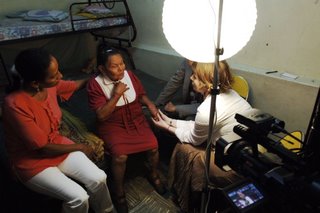
Maria was a difficult interview. Difficult because she tended to talk about whatever she wanted to talk about, ignoring my questions. And even more difficult because her life story is so tragic.
During Colombia's Great Violence, Maria and her husband lived on a mountain near Cali, along with their seven young children. Her husband was murdered by guerillas, his body eaten by vultures. Fearing the safety of her children, Maria took her family and fled down the mountain. They were many days without food or water. Maria tells the story of one particular night when she and the children were sleeping outside in the rain. She was awakened by a voice calling her name. At first she thought it was her husband's voice, but she knew it could not be. The voice called to her to wake up. She did, and she discovered that the river had flooded its banks and that she and her children were in danger of being swept away. So she gathered her children and moved on to higher ground. She swears that the voice that saved them was the voice of God.
But Maria's story takes a twist, as before she and her children were able to escape the mountain, all seven kids died of starvation or hypothermia. What a terrible thing for a mother to endure... watching helplessly as her children died slow and painful deaths! She is haunted by the memories still. As she recounts the story, her hands clinch tightly and she contorts her face in agony. She is quite possibly the most angry and emotionally scarred person I have ever met.
In her old age, she depends on the kindness and generosity of others to survive. The Cali Central Cumberland Presbyterian Church pays for her to stay in a nursing home. And when Hogar Samaria is ready, Maria will have a place to live out her final years. She says that without the church, she doesn't know where she would live or where she would die.
(photo by Mark Mosrie)
Monday, April 24, 2006
Hope for Cali

Sunday was very intense. I spent the entire day screening interviews. Over the weeks that now separate me from my time in Colombia, the impact of the people I'd met and the emotional stories they'd revealed to me had begun to fade. It has now been renewed and strengthened tenfold! It was difficult to watch the interviews one right after another... several days of shooting condensed into one long day of viewing.
I ended the evening by screening some footage we shot at Colegio Americano in the San Marcos barrio, where the children sang for us and performed traditional dances. They waved little paper flags... ours and theirs. Moments like these give us hope for Colombia's future.
The transcription of the Spanish-language interviews began tonight. Translation into English will follow shortly. At this point, we are on target for debuting the documentary in September. To help offset production costs, you're invited to send your tax-deductible donations to Shepherd's Rest, 605 Lake Scene Dr., Eddyville, KY 42038. Earmark donation for Hogar Samaria Video.
(photo by P.Richelle White)
Saturday, April 15, 2006
Hogar Samaria Video Project
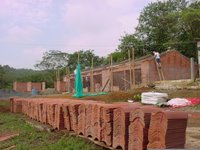
Production of the Hogar Samaria Video has begun! We shot 15 hours of miniDV in Cali, Colombia in March, using my new Panasonic DVX-100B. I can hardly wait to start writing the script! But first, every interview has to be transcribed and translated. Many of the interviews are in Spanish, and those will need to be translated into English before I can start working. Some of the interviews are in English, and those need to be translated to Spanish for the Spanish-language version I will also be producing. Right now the target is to begin editing in June. I'll keep you posted!
In the meantime, we still have a cash flow shortage. Your tax-deductible donations will help fund the production of this documentary, which in turn will help fund the construction of a much-needed nursing home in Cali. If you feel led to support this project, please send your donation to Shepherd's Rest, 605 Lake Scene Dr., Eddyville, KY 42038. Earmark donation for Hogar Samaria Video.
(photo by P.Richelle White)
Subscribe to:
Posts (Atom)

